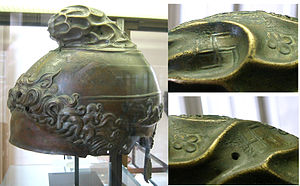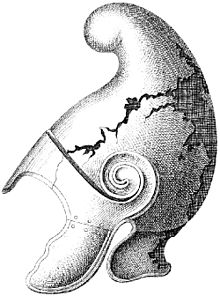Phrygian helmet
| Phrygian helmet | |
|---|---|

|
|
| Information | |
| Region of origin / author: |
Ancient Greece |
| Lists on the subject | |
A Phrygian or Thracian helmet is an ancient type of helmet made of bronze , which was mainly worn by the ancient Greeks and in the Hellenistic influenced countries.
description
The dome (helmet bell) was shaped high and in many cases had a tip that was inclined forwards or overran, similar to the Phrygian cap . Other features were a narrow visor and large, attached cheek pieces that offered good protection for the face. The latter were also reminiscent of the Phrygian cap that was worn by the Thracians . The cheek pieces could also be fused to the chin and upper lip, in this case they are called "beard" (in fact, a beard was often embossed as an ornament). A horse's mane or feathers could sometimes be attached to the bell. Movable cheek flaps and wings were also attached to the helmets.
This type of helmet can already be found on late Hittite sculptures of the 8th century BC. BC, in the New Assyrian Empire and on Cyprus . According to representations in Greek art, he was from the 5th century BC. Until the 2nd century BC More commonly used. The main areas of the finds are the Danube estuary , Greece and southern Italy .
origin
Based on descriptions of helmets and items of clothing in the Homeric epics and the results of experimental archeology in the 1970s, Gérard Seiterle reconstructed the "Homeric leather helmet" as the common forerunner of the Phrygian helmet and Phrygian cap. According to this, the korys (or kyneae ) tryphalos or amphiphalos was originally a helmet made of hard-dried cowhide, more precisely: from the fur around the scrotum of a bull, which was reinforced early on with parts made of bronze and then reproduced entirely in bronze has been. The decorative epithets tryphalos and amphiphalos mean something like : "provided with four phaloi " or " provided with phaloi on both sides ", the rarer aulopsis : "tubular" (literally "stem-eyed"). These phaloi, which were previously difficult to interpret, were probably the four stunted teats of the bull, which are arranged in pairs and are located directly in front of the scrotum. When the leather put over a dummy head dries, these teats harden into horn-like, tubular spines that adorn and additionally reinforce the forehead of the helmet. The scrotum was stuffed and bent forward (Homer called it kymbachos ). This resulted in a good basis for attaching a helmet bush made of horsehair with a favorable weight distribution ( lophos , cf. the Roman crista ). A band of leather or metal ( stephane ) was placed around the calotte , which covered the seam between the calotte and the leather cheek and neck protectors. In addition, Homer mentions another headgear made of bull leather called kataityx . From the fact that it was labeled as aphalos (without phaloi) and alophos (without bush), Seiterle concludes that this headgear was made of the same material as the helmet described, but was not hard-dried, but tanned soft . This headgear used by lightly armed men and women who were reporting runners probably continued to have long ear and neck flaps, as was the case with early forms of the Phrygian cap.
literature
- Thomas Schäfer : Andres Agathoi. Studies on the reality content of the armament of Attic warriors on monuments of the classical period (= sources and research on the ancient world. Vol. 27). Tuduv-Verlags-Gesellschaft, Munich 1997, ISBN 3-88073-554-9 (plus habilitation thesis, University of Frankfurt am Main 1994).
- Yearbook of the German Archaeological Institute. Vol. 114, 1999, ISSN 0931-7007 .
- Jürgen Borchhardt : Homeric helmets. Helmet shapes of the Aegean in their relationship to Oriental and European helmets in the Bronze and Early Iron Ages. von Zabern, Mainz 1972.
Individual evidence
- ↑ Gérard Seiterle: Die Urform der Phrygischen Mütze , In: Antike Welt: Zeitschrift für Archäologie und Kulturgeschichte , 16/3, S. 4–7, von Zabern, Darmstadt 1985.

